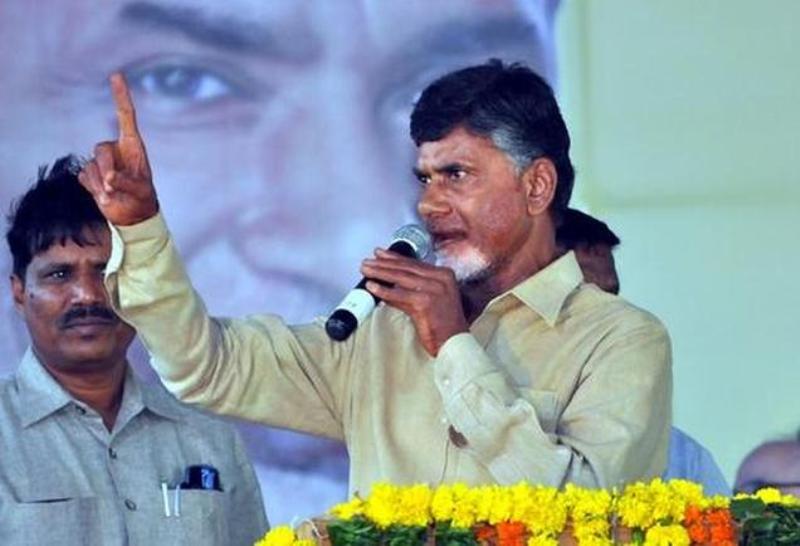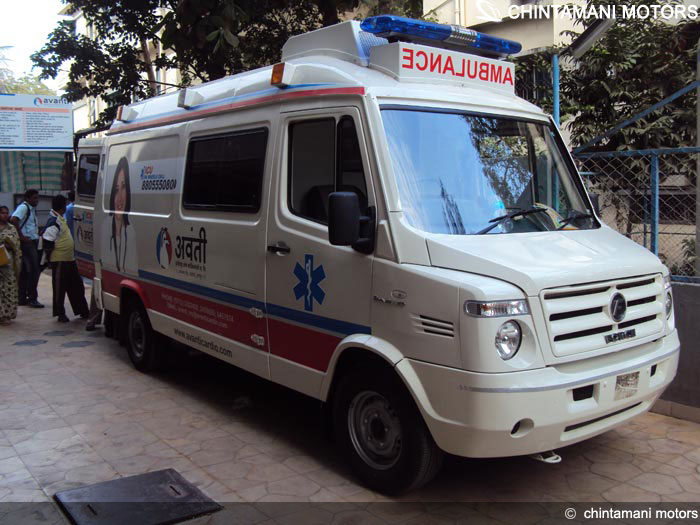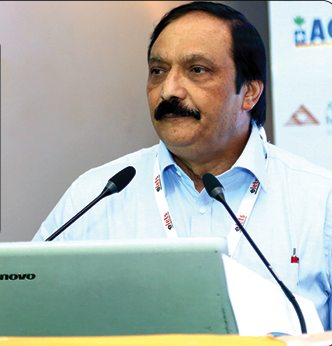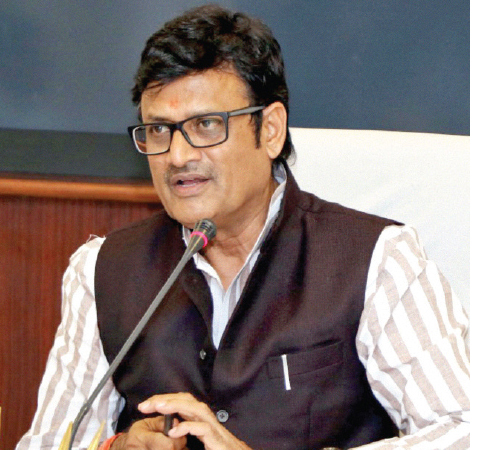
 With the surge of new ideas, approaches and institutions in Gujarat, the state has become one of the most favoured medical destinations in the recent times. Dhirendra Pratap Singh analyses on public health services in Gujarat
With the surge of new ideas, approaches and institutions in Gujarat, the state has become one of the most favoured medical destinations in the recent times. Dhirendra Pratap Singh analyses on public health services in Gujarat
Narendra Modi, Chief Minister of Gujarat, usually inspires the youth by saying, In life, dont try to be something. Instead of that, try to do something. Even if you fail, do not get disheartened, there is no shame in failure. Commit yourself with full of your strength. Do not bother that someone accompanies you or not. Have faith in your inner capabilities. Have courage to go alone, march towards your goal.

Offering a combination of good governance, speedy implementation, brisk decision making, abundant and undisputed resources, Modi has successfully positioned Gujarat as a healthcare destination. The healthcare landscape in Gujarat is changing rapidly. Actually, healthcare systems are usually large, complex and slow to respond to change. But the surge of new ideas, approaches and institutions in Gujarat is melting away the age-old barriers to change. The state of Gujarat is writing a new chapter in healthcare.
The dilemma in India is there are huge differences in public and private healthcare, there is need to ponder on how to bridge the gap. Robust IT healthcare system with well motivated health professionals will pave the way for betterment
Keshav Desiraju
Additional Secretary, Ministry of Health & Family Welfare, Government of India

Says Ravi Saxena, Additional Chief Secretary, (DST), Gujarat, Increasing access to technology is one thing, but the objective is to reach the last person in the queue, and to deliver the benefits that he or she is entitled to. This is the pillar of policy that we implemented in Gujarat.
The available medical infrastructure and easily accessible healthcare facilities have improved the health of the population of the state remarkably over the years. The State Government is taking several initiatives to make Gujarat a global healthcare destination. Gujarat is evolving in terms of number of hospitals, healthcare centres, beds and is expected to continue a positive trend in future. Doctor to patient ratio is 1:10 and nurse to patient ratio is 1:5. By the use of latest technical equipment, efficient health insurance, major corporate investments and the services of highly skilled medical personnel, the Gujarat healthcare sector has set itself on a boom. Healthcare sector in the state has potential to grow at a much faster rate in the foreseeable future and shall be numero uno in providing healthcare facilities.

Big bet on PPP
The state government is aiming high on the public private partnership (PPP) model for the healthcare sector in coming years as technology-driven medical services are expected to bring a makeover to the states image by making it a hub for medical tourism.
Some experts believe that there is a need for a PPP model in the medical infrastructure and treatment delivery system in India. The government sits on one of the largest infrastructures and partners with private players which may bring in better staffing and managerial expertise. The compulsions of technology-driven treatments would make the public sector to look at private sector for capital and technology, while the private sector would look up to public sector for patient pool, thereby making the PPP model imminent for the effective medical infrastructure.
Various hospitals in private sector are engaged with Gujarat Government in PPP model. Wockhardt Hospitals Group (WHG) along with the Government of Gujarat will conduct and manage the 275-bed Palanpur Civil General Hospital. Civil Hospital, Ahmedabad is getting aid from the Central Government under Pradhanmantri Swasthya Sudhar Yojana. Started in 2005-06, the hospital has till date received ` 100 crore from the centre.
Under this scheme, a hospital is identified from each state and is given aid by the Central Government to develop one AIIMS-like institution. The hospital has also received aid of `20 crore from the Government of Gujarat to develop it as Asias largest medicity. Narayana Hruduyalaya, Fortis Healthcare, and Artemis Group of Hospitals are planning to set up medical colleges in the State.
Says Anju Sharma, Mission Director, NRHM on Government Initiatives in healthcare, Gujarat has been an enthusiastic state to bring quality healthcare to the citizens with a long range of programmes such as Chiranjeevi and Balsakha Yojana (PPP), 108 Emergency Transport and e-Mamta Mother & Child tracking (IT application). We have district quality accreditation boards Quality Assurance Group (QAG), Quality Improvement Programme (QIP), NABH.
Sarva Swastha Abhiyan (SSA, an NGO dedicated to taking quality healthcare to inaccessible areas) has opened 10 centres in five predominantly tribal areas of Idar, Prantij, Bardoli, Hansot and Mundra that will be connected through telemedicine to the super speciality hospitals at Ahmedabad, Nadiad, Vadodara and Surat.
Says Anju Sharma, Gujarat is the first state which has accredited PHCs in tribal areas by NABH, blood banks, food and drug laboratory and of course the hospitals to involve quality consciousness into the system. The most talked about programme initiated by Gujarat in the year 2006 is the Chiranjeevi Yojna which is a unique PPP initiative to partner with private sector facilities for BPL and tribal mothers. There is an evident reduction in number of maternal deaths and we could infer to have saved approximately 893 mothers.
Increasing access to technology is one thing, but the objective is to reach the last person in the queue, and to deliver the benefits that he or she is entitled to. This is the pillar of policy that we implemented in Gujarat
Ravi Saxena
Additional Chief Secretary, (DST), Gujarat
 Talking further she says, The Bal Sakha scheme provides expert care to newborns up to one month by private pediatricians / trust hospitals free of cost. The emergency ambulance 108 was initiated in the year 2007, which answers 99 percent calls and so far has attended total emergencies to be around 15, 51,718.
Talking further she says, The Bal Sakha scheme provides expert care to newborns up to one month by private pediatricians / trust hospitals free of cost. The emergency ambulance 108 was initiated in the year 2007, which answers 99 percent calls and so far has attended total emergencies to be around 15, 51,718.
It is estimated that in the state of Gujarat about 1.2 million children are born each year and 4600 of these mothers do not survive at the time of delivery because of several reasons. The maternal mortality rate for the state is 389 per 100,000 live births. Primary reason for these maternal deaths is that majority of the deliveries are domiciliary and are conducted by untrained persons in unhygienic conditions.
It is argued that most of these maternal deaths are avoidable if adequate interventions are undertaken. Among the groups, below poverty line (BPL) families are the most vulnerable since they face significant risk owing to their poor socio-economic status and limited access to healthcare services.
Institutional Deliveries
Chiranjeevi Yojana is working towards long life of mothers and babies in Gujarat. Implemented by the Government of Gujarat, this scheme aims at encouraging the BPL families to improve access to institutional delivery. This is done by providing financial protection to these families and covering their out-of-pocket costs incurred on travel to reach the healthcare facility. The scheme also provides for financial support to the accompanying person for loss of wages. This scheme empowers the poor to seek skilled care and emergency obstetric care. The scheme uses several mechanisms to target the BPL family. Among them, the main mechanism being used is the BPL card.
Gujarat has been an enthusiastic state to bring quality healthcare to the citizens with a long range of programmes
Anju Sharma
Mission Director, NRHM, Gujarat
When the scheme was initiated, the pilot districts were selected based on remoteness and included regions facing highest infant mortality and maternal mortality. The private medical practitioners (mainly gynaecologists) in these regions were empanelled in the scheme to provide maternity health services. These providers have reimbursed a fixed rate for deliveries carried out by them. Five CHCs (Malav, Shamlaji, Rajsitapur, Mota Phospholiya, Golagandi) and PHC (Chansad) are being run by community based organisations under this scheme. Under the scheme, the health department has empanelled and contracted private practicing gynaecologists who had their own small hospitals in rural areas using a few selection criteria.
Centre for Health, Education, Training and Nutrition Awareness (CHETNA) has been actively supporting a total of 14 mother NGOs working effectively to implement Reproductive and Child Program (RCH).
ICT in Healthcare
Says Keshav Desiraju, Additional Secretary, Ministry of Health & Family Welfare, Government of India, Still a lot needs to be done in health sector of India, especially adapting IT in healthcare is a huge job. Vast network of public health exists and we need to think how we can improve it using IT. IT can help tackle issues of high rate of infant and maternal mortality.
When a parent in Gujarat doesnt remember to vaccinate an infant, Gujarat governments e-Mamta scheme will know, and ensure it gets done in time. It is the kind of motherly system that will remind a childs needs — even if the mother forgets. This project, which even the Union government is now considering to replicate in various states of the country, tracks and monitors the health of pregnant women and children up to six years.
Everything about a child, from his very conception to education, is tracked and monitored under this system. Also, for parents giving out their cellphone numbers, vaccination alerts would be received via SMS on specific dates. The programme has improved reporting of maternal deaths from 589 to 702 over previous year and reporting of infant deaths from 4732 to 7263 over previous year.
Illustrating role of innovation in healthcare Anju Sharma says, In healthcare delivery, innovation is important because there are challenges in healthcare delivery of access, availability, affordability and quality. e-Mamta mother and child tracking web based application is a credible tracking system that would enable health workers to reach above mentioned goals.
The department of Health and Family Welfare, Govt. of Gujarat has conceptualised Hospital Management and Information System (HMIS) in Gujarat to ensure the quality health using Information and Communication Technology (ICT) as the tool to provide standard clinical and diagnostic tools, hospital management tools and integration of management information at the state level to ensure online review and monitoring.
 The aim is management of vital patient records, analysis of the critical health related data so as to provide an updated planning and policy tool towards provision of quality health services. The programme assists the doctors and medical staff to improve health services with readily reference patient data, work flow enabled less-paper process and parameterised alarms and triggers during patient treatment cycle.
The aim is management of vital patient records, analysis of the critical health related data so as to provide an updated planning and policy tool towards provision of quality health services. The programme assists the doctors and medical staff to improve health services with readily reference patient data, work flow enabled less-paper process and parameterised alarms and triggers during patient treatment cycle.
Says Keshav Desiraju, Problem exists with health human resources in India that needs attention. The dilemma in India is there are huge differences in public and private healthcare, there is need to ponder on how to bridge the gap. Robust IT healthcare system with well motivated health professionals will pave the way for betterment.
Gujarat has turned around its status in emergency medical services which was in a neglected state a decade back by bringing qualitative and grass-rooted changes in it. Gujarat Government with the Emergency Medical Research Institute (EMRI) takes care of road and fire accident victims on a 24-hour basis through the year by just dialing 108. The state-wide 108 emergency medical response network is providing free-of-cost, selfless and reliable emergency services. Gujarat Government had allotted GVK EMRI a plot near Kathawada to establish a high-tech emergency and research management centre in the state. The emergency ambulance 108 was initiated in the year 2007, which answers 99 percent calls and so far has attended total emergencies to be around 15, 51,718.
Integrated Insurance Scheme
This community based health insurance scheme is run by NGO-Self-Employed Women Association (SEWA), based in Ahmedabad, Gujarat. One of its primary activities is providing financial services for women. The scheme initially targeted just women in the informal sector but now includes men too. Members must be between 18 and 60 years old and a member of the SEWA union. They are asked to pay 85 per annum. In addition, women members can become lifetime members by paying a fixed deposit of ` 1,000 and the interest on this is used to pay the annual premium. The deposit is returned to her when she turns 60. The scheme covers: (i) Inpatient care (ii) Hospitalisation cover, plus one-time payment for denture and hearing aid. Members can use any kind of hospital, public, private or trust. (iii) Delivery benefits for fixed deposits members. The scheme is managed by SEWA which purchases medical insurance from a government insurance company subsidiary National Insurance Company (NIC) and ICICI Lombard. Reimbursement takes place on average just over three months after discharge from hospital depending on when the claim is made.
New techniques are workable to address health challenges in our country, and I believe that each state government will notice a lot of potential in the ICT tools, in the years to come
Dr Neeta Shah
Director (e-Governance), Gujarat Informatics Ltd
In the current year 2011-12, the Rastriya Swasthya Bima Yojana (RSBY) policy in 26 districts of Gujarat is being renewed and in addition to the eligible rural BPL families, the scheme is being extended to all the eligible 9.5 lakh urban BPL families of the state as well. More than 3.0 lakh BPL families have been enrolled till date.
 Upcoming Trends: Medical Tourism
Upcoming Trends: Medical Tourism
Gujarats medical expertise and the strength of its facilities are better than those of some of the South East Asian Nations and Gujarat hospitals are trying to do a lot more hard selling abroad. The state offers tremendous potential to develop medical tourism particularly in its major cities like Ahmedabad, Baroda, Surat and Rajkot. Healthcare is available at very competitive charges so Gujarat has become a lucrative destination for people wanting to undergo the best treatment at cost-effective rates.
The medical tourism in Gujarat will flourish with more and more technology-driven treatments being available in the state. This is the state which will be known in the world for its medical tourism by 2025. Gujarat has a potential to attract at least one million medical tourists every year. For this, joint participation of private sector and public sector is crucial, said Sri Jay Narayan Vyas at a conference on Public Private Partnership Policy Framework in Ahmedabad.
According to State Ministry for Health and Tourism, Gujarat, last year 4.50 lakh tourists visited the state for obtaining medical care. The Gujarat community comprises of 32 percent of the total 20.1 million people of Indian origin worldwide. According to a study by Confederation of Indian Industry (CII), India has a competitive edge especially its cost advantage. The Cost of Medical treatment in India is less than 1/3rd of that in many European and US Hospitals. Gujarat doctors are attaining international conferences to understand latest treatment and hospital set up as international standards to give patient best quality treatment.
Each Corporate hospital in Gujarat receives about 60-70 international patients per month (during October to March). Key Drivers of medical tourism in Gujarat are: highest number of airports in India, excellent rail-road connectivity in Gujarat; state-of-art multispecialty hospital and cost benefits.
Commercial surrogacy or what has been called wombs for rent is growing in India. While no reliable numbers track such pregnancies nationwide, doctors work with surrogates in virtually every major city. The women are impregnated in-vitro with the egg and sperm of couples unable to conceive on their own. Anand (a district in Gujarat) is renowned globally as a pioneer in offering paid surrogacy through the in-vitro fertilisation technique.
Commercial surrogacy has been legal in India since 2002, as it is in many other countries, including the United States. But India is the leader in making it a viable industry rather than a rare fertility treatment. Experts say it could take off for the same reasons outsourcing in other industries has been successful: a wide labor pool working for relatively low rates.
Research
In order to initiate clinicians in the concept of scientific evidence-based medicine and to address burning medical and epidemiological questions, many hospitals in Gujarat are engaged into clinical research. VEEDA CR, Indias fastest growing Clinical Research Organisation (CRO), has opened its new clinical pharmacology Unit (CPU) at Muljibhai Patel Urological Hospital (MPUH), Nadiad, Gujarat. Pulse Womens Hospital Pvt. Ltd is engaged into infertility, foetal medicine, embryology; Krishna Heart Institute is engaged into stem cell therapy, cardial drugs; Apollo-Radiation therapy into cancer care; Rajasthan Hospital-Plastic and Burns, Hematology, Otolaryngology, Anaesthesiology; Sterling Addlife India Ltd-Nephrology, Oncology, Respiratory System, Cardiology and IKDRC is engaged into clinical research activities related to Nephrology. Muljibhai Patel Urological Hospital will become the only hospital in Gujarat and second after AIIMS in the country to start nephrourological surgeries using robotic technology.
Says Dr Neeta Shah, Director (e-Governance), Gujarat Informatics Ltd, New techniques are workable to address health challenges in our country, and I believe that each state government will notice a lot of potential in the ICT tools, in the years to come.
Based on the experience of Gujarat state, other states where private providers are available and where government services are non-functional or of poor quality, the state governments can explore the options of PPP and healthcare innovations to provide comprehensive healthcare services for the larger population in India.
Be a part of Elets Collaborative Initiatives. Join Us for Upcoming Events and explore business opportunities. Like us on Facebook , connect with us on LinkedIn and follow us on Twitter , Instagram.

















